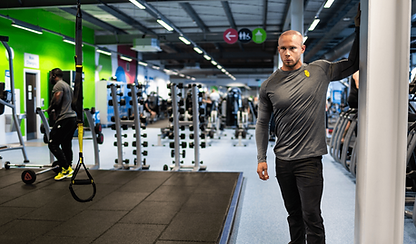
OSTEOPATHIC MUSCULOSKELETAL CLINIC Solihull | Henley In Arden | Birmingham
Tel: 01564330773 Clinic: 07966317712 Email: info@dynamicosteopaths.com
(in collaboration with Grenade® Nutrition)
UPDATED ARTICLES ON INJURY PREVENTION
In this section, we will discuss recent updates and brief overview articles on:
-
INJURY PREVENTION
-
PERFORMANCE
-
SPORTS INJURIES
ARTICLES
POSTURE
5 QUICK STRETCHES TO HELP IMPROVE YOUR POSTURE
Does sitting and being sedentary all day give you backache other niggles? Often people, in this case, can find it very difficult to get comfortable, which can be extremely frustrating! This article we give you 5 quick and easy to perform stretches to help improve your posture and banish those aches and niggles associated with posture and sedentary lifestyles.
Poor posture is very common and is often a cause of many complaints especially the back and neck. This is because it causes imbalances and throws the muscles out of normal alignment. It's extremely important to work at correcting your posture and implement preventative measures to help you avoid potential injuries. Maintaining a good natural posture will help in preventing posture-related aches and pains. The spine curvature works as a shock absorber, helping to distribute weight along the length of your spine and adjusting postural distortions can help prevent issues. Carrying out these 5 quick and easy postural corrective stretches can help you re-educate your muscles and help to avoid being stuck in a hunched uncomfortable position and to restore normal function.
INJURY PREVENTION
HOW TO PREVENT SHIN SPLINTS
Whether you're an experienced runner or just getting started, you could be at risk of developing shin splints. Here we are going to give you 6 quick preventative stretches to help with shin splints. We will go through some options on how to prevent the likelihood of developing shin splints and discuss an understanding on what shin splints is, whether you are likely to develop it and how to strengthen specific areas of your body to help you to prevent the onset of this painful condition.
If you are a keen runner you will more than likely understand the basics of what shin splints are and how they can affect your performance. Many athletes, especially runners, will experience the common pain associated with shin splints. This can particularly appear if the individual is new to an activity (such as running), or suddenly increases their tempo or environment. For example, if they begin training on hard concrete or uneven surfaces.
Shin splints are known as 'medial tibial stress syndrome' or 'periostitis', which means injury to the connective muscle tissue on the inside of the shin bone. It is commonly associated with repetitive overuse, hence why it is common amongst runners.
INJURY PREVENTION
BASIC BACK STRETCHES
3 basic post-treatment exercises post-treatment exercises
For further information please contact us on 01564 330773 or alternatively email us at info@dynamicosteopaths.com
INJURY PREVENTION
Suffering from sore and tired muscles? Maybe you need to improve your mobility or practice your injury prevention. Maybe foam rolling may just be the answer to your problems.
You may be familiar with the piece of equipment that is the foam roller. Perhaps you’ve given it a go but not too sure how to use it. Here we are going to talk more about the benefits of foam rolling and why it’s a popular piece of equipment with runners, gym-goers and athletes alike.
HOW TO TREAT TIRED MUSCLES WITH FOAM ROLLING
INJURY PREVENTION
We spend every day dealing with a wide variety of injuries. It is for this reason that we maintain our philosophy around the importance of joint preservation as part of wider injury prevention. This is done via pre-habilitation or ‘pre-hab’ - acting before an injury occurs.
Below we cover the basic ‘pre-hab’ guidelines commonly used in sports injury and performance medicine, with particular focus on the lower back in this article.
PRE-HABILITATION (PRE-HAB) SPINE AND LOWER BACK
INJURY PREVENTION
PRE-HABILITATION (PRE-HAB) KNEE & SHOULDER
Here, we take a look into how you can 'injury-proof' and look after your joints to help with the prevention of injury. Spine and lower back can be found here article specifically looks at your knees and shoulders.
PREHAB FOR THE KNEE
The second most common complaint is the knee because so much force passes through. The hip and the knee are both to be considered during 'pre-hab', due to the closely linked function they both have. Therefore, knee rehab will focus mainly on hip strength, hamstring and glute strength, as it's these areas that stabilise the knee. I often see knee complaints and dysfunction regularly brought on by huge imbalances in the leg muscles, which in turn leads to poor biomechanics. Here, I will focus on some simple exercises to combat this.
INJURY PREVENTION
HOW MUCH REST DO WE NEED?
When looking at exercise, rest days are an essential part of our routine and must be factored in and structured accordingly. Often people put themselves under high amounts of pressure that they MUST train everyday, otherwise they feel like they’re slacking or NOT gaining. On the contrary. Time off allows your body to recover and grow, ultimately increasing your performance.
Everyone knows the feeling of having a bad night’s sleep and its effect on our mental and physical capabilities, similarly to over-training. Your body starts to fall into what is known as a catabolic state (muscle break down). In addition, this can produce an unwanted stress hormone cortisol, which can be harmful for everything if in excess. This is a similar process to what happens if you do not allow it to recover from increased exercise. Let’s dig a little deeper.
THIS PAGE IS UNDERGOING A BUILDING PROCESS AND UPDATES WILL BE DONE EVERYDAY...







